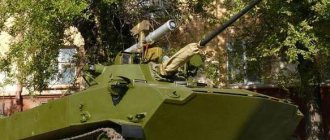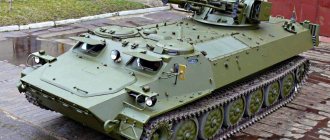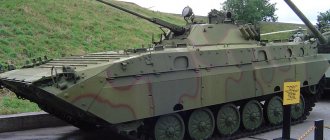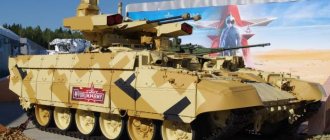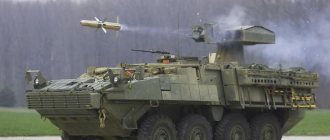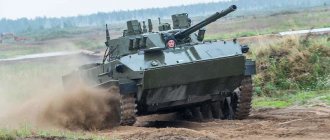BRM Fenech is the brainchild of Dutch and German engineers. The light armored vehicle MRS (Multipurpuse Carrier - multi-purpose vehicle) is designed for reconnaissance activities, participation in combat clashes, and patrolling. The vehicle was designed taking into account all the requirements for armed equipment of European countries.
The name BRM Fennec comes from the analogy with the miniature desert fox, characterized by sensitive hearing and keen eyesight.
The first MPC Fennek prototype was built in 1992. In 1996, Germany and the Netherlands each received two cars for testing in their countries. According to the military, this car is considered one of the best in its class.
Fennek is a wheeled platform on the basis of which up to 8 different types of combat vehicles can be implemented, depending on the assigned tasks.
History of the creation of the BRM Fenech
Germany (Krauss-Maffei Wegmann) and the Netherlands (SP Aerospace + Vehicle Systems BV) have been jointly developing the Fennek light reconnaissance armored vehicle that meets modern requirements almost since the beginning of the 1990s. The Fennec prototype was ready in 1992, and mass production began in 2001.
The initial order for the Fennek MPC amounted to 612 vehicles, 2/3 of which were intended for the Netherlands, and the remaining for Germany. It is interesting that the specification of the vehicle does not even suggest a classic reconnaissance army armored vehicle, but rather a combat patrol vehicle for counter-guerrilla operations, that is, for conflicts such as the wars in Afghanistan and Syria, Germany and the Netherlands began to prepare in advance.
In addition to patrolling, the responsibilities of the Fenech BRM include such traditional tasks for light armored cars as conducting electronic and visual reconnaissance, engineering reconnaissance, and supplying units in combat conditions.
Since 2004, the vehicles have been tested in Afghanistan and performed quite well. The vehicle performed well in the tasks of reconnaissance of vast areas with a large gap from other forces, and control of key routes. In everyday service, Fenech BRMs are most often used to guard convoys, as part of special escort forces.
If necessary, in field conditions, the protection of armored vehicles can be enhanced by mounting overhead armor plates on the hull. The Dutch successfully used a similar scheme on their cars.
Keeping fennec at home
According to some, man managed to tame only the fennec cat, which represents the order of foxes, although in fact this is not the case. There is another domesticated fox, artificially bred at the Novosibirsk Institute of Cytology and Genetics.
Interesting to know! At one time, Antoine de Saint-Exupéry managed to tame the fennec cat in his famous story “The Little Prince”. In 1935, in the sands of the Sahara, he managed to meet this unique animal, after which this animal became a fairy-tale character in his work.
There are very few nurseries in our country that practice breeding these animals. That is why, to get a fennec cat at home, you will have to pay at least 25 thousand rubles. But even such a high cost does not guarantee that, having paid money, you can immediately choose a fox. Many people wait in line for months, or even years, until new offspring are born. Therefore, you can use the services of private breeders or contact the zoo.
In the case when a decision is made to purchase such an animal, you must be prepared for the fact that you will have to sacrifice part of the usable space, ensuring freedom of movement for the animal. As you know, this is an energetic animal that loves to run and jump a lot.
Rules of care and hygiene
The pygmy fox does not require special care, but there is a small problem associated with its thick fur. Shedding occurs 2 times a year, so during this period it is advisable to systematically comb out dying hairs.
These pets emit practically no foreign odors, but in case of danger, the fox can emit a musky odor that quickly disappears. If you do not clean the tray for a long time, a specific smell may come out. To prevent this from happening, you need to systematically wash the tray.
Important point! When the foxes are small, you need to be careful with them, because they love to be near human feet, and they do it unnoticed.
Therefore, you can easily step on a fox cub, injuring it. It follows from this that it is always necessary to monitor the location of your pet.
Content issues
Keeping a fennec cat at home is associated with some features that everyone who wants to have such a pet needs to know about.
Since fennec cats are very social animals, they use a lot of different sounds for their communication, which they use to communicate with their owner and family members. Although there is other evidence indicating that there may be silent people among them.
For the normal functioning of the fennec, it is necessary to pay attention to such factors as:
- Providing your pet with a spacious enclosure, but always warm.
- Poor adaptation of the animal to correcting the need for a tray.
- It is advisable to provide the animal with live food.
- The dwarf fox prefers to be nocturnal.
- Few veterinarians specialize in wild animals.
Owners of such pets indicate that they do not cause allergies and are easily tamed, although they react with fear to the slightest extraneous sounds, especially unexpected ones.
The disadvantage of these animals is that they can bite family members on the legs, and this brings a lot of discomfort.
What to feed a pygmy fox
The diet of this animal should include dishes high in protein.
The animal must be fed every day:
- Mealworms or silkworms, crickets, etc.
- Eggs of any origin.
- Rodents, including adults.
- Meat based cat food.
At the same time, we should not forget about food products containing many vitamins and minerals, which is typical for dietary nutrition. Therefore, fennec cats should include frozen fruits and vegetables in their diet, in the form of tomatoes, broccoli, etc. You can add 500 mg of taurine daily, which is mixed with worms, insects or vegetables. Sweets and food from the human table are contraindicated for pets.
To determine which foods are not digested by the fennec cat’s body, you need to look into its tray. As a rule, unhealthy vegetables include: carrots, corn, and all grains. If you give your pygmy fox cranberries or cherries, they can neutralize the smell of urine. It is necessary to have dishes with clean drinking water.
How to live with the biggest eared fox? Impossible?
Car design
BRM Fenech is a wheeled, two-axle, all-wheel drive, non-floating vehicle, the engine of which was located at the rear. The developers chose a rear-engine assembly because it reduced thermal and acoustic signature. The driver's workplace was located in front of the car.
Due to the fact that the armored car had large armored windows, which were equipped with wipers, the driver was guaranteed a large field of view. The possibility of attaching a special coating screen to the glass that prevents light from being reflected from the sun was also taken into account.
The MPC Fennek was equipped with a rear-view camera and night vision goggles for the dark. The remaining crew members were located behind the driver. Access to the places was provided using doors on the side of the hull. In addition, there were hatches above all three crew members. The seats were height adjustable, allowing monitoring through a hidden hatch.
The special equipment of this vehicle allowed monitoring during the day and at night; measure range and azimuths, and exchange all relevant data with headquarters.
Specifications MPC Fennek
| Manufacturer country | Germany and the Netherlands |
| Machine type | Reconnaissance armored vehicle (4x4) |
| Date of issue | 2000 |
| Vehicle height/length/width | 1790/5580/2550 mm |
| Armor on the front, side, turret | Steel, rolled, provides protection against 7.62 mm armor-piercing bullets |
| Crew composition | 3 persons |
| Engine | Daimler diesel, 240 hp. |
| Range | 1000 km highway, 450 km cross-country |
| Maximum speed | 115 km/h |
| Weight | 9.7 tons |
| Armament | 1x 12.7 mm Browning M2 machine gun or 1x 7.62 mm Rheinmetall MG-3. Additionally, 1x 40-mm HK GMG grenade launcher (32 rounds) can be installed |
Machine equipment
The gearbox is automatic, the steering is equipped with a hydraulic booster. The Fennec is equipped with a filter ventilation system and a central tire pressure regulation system.
To carry out reconnaissance, a telescopic mast is used on which a container with equipment is installed, including an infrared and TV camera, and a laser range finder. The standard GPS receiver provides accurate location to the terrain; all collected data is transferred to the unit's automated combat control system.
Special equipment of the BRM allows observation in the daytime and at night, measurement of range and azimuths, as well as the exchange of relevant information. It is based on a VAA optoelectronic head (developed by Carl Zeiss Optronics) with a television camera, an OPHELIOS thermal imager and a MOLEM laser rangefinder. The head is mounted on a telescopic mast 1.5 m high, allowing observation from behind shelters. The BAA mounting system provides all-round visibility, but the head cannot be rotated 360°: it rotates 220° to the right and left. The range of movement of the VAA in the vertical plane is from −30 to +30°. There is also the possibility of equipping a remote observation post - in this case, the VAA head is installed on a special tripod at a distance of up to 40 m from the BRM.
The OPHELIOS thermal imager operates in the range of 8-12 microns and provides detection of a tank-type target at a distance of up to 4 km. A black-and-white television camera has an adjustable field of view from 2 to 20° (for a thermal imager this figure ranges from 2.7 to 12.5°). The image is transmitted to the monitor, and it is possible to superimpose the image from the thermal imager onto the television one. The laser rangefinder operates at a wavelength of 1.543 microns. The range measurement range is from 50 m to 10 km, the measurement time is 10 ns. The measured distance to the object is displayed on the monitor, and the results of the last 50 measurements are stored in memory. The monitor also displays the azimuth of the object relative to the BRM and the tilt angle of the BAA head.
As you know, when conducting reconnaissance, it is extremely important to know your exact location. Fenech is equipped with an inertial navigation system LLN-GY developed by LITEF. It provides the crew with information about current coordinates in real time. The accuracy of determining one's own position is 10 m, and the error is 0.8% of the distance traveled. North direction information is also provided (with an accuracy of 0.3°). In addition, Fenech is equipped with a GPS satellite navigation system receiver.
The BRM is equipped with a FuWES information display and transmission system. Its touchscreen monitor, installed to the left of the BAA system monitor, displays a map of the area with detected objects and the range to them, as well as the location of the BRM itself. This information can be broadcast to external consumers.
German forces use Weapons Commands and Systems (FueWES), a universal interface that makes it easy to use alternative hardware and software capabilities of individual countries (NATO).
Additional means of observation are remote acoustic and seismic sensors. It is also possible to use the miniature Aladdin UAV from Fenech. This drone has a range of 15 km and a maximum flight speed of 90 km/h. The operating altitude range of Aladdin is from 30 to 300 m.
Fenech has a developed set of radio communications, including HF/VHF radios SEM 52, SEM 80/90 and HRM 7400, as well as a tank intercom.
The reconnaissance version of the Fenech's armament is mounted on a Type 1530 turret with manual aiming, but with remote control from inside the vehicle. In the Bundeswehr, the BRM is armed with a 7.62 mm machine gun or a 40 mm AGL grenade launcher (ready-to-fire ammunition capacity is 250 rounds or 32 grenades). For aiming, a PERI Z17 periscope sight and a thermal imager are used. It is possible to install a more complex LAZ400L sighting station with a television camera, thermal imager and laser rangefinder. Instead of a Type 1530 turret, a remote-controlled FLW 200 installation with an electric drive and additional smoke grenade launchers can be mounted (in the basic version, six 76-mm grenade launchers, interlocked in two packages, are installed in the rear of the hull). It is also possible to use other weapon options - for example, the BRMs of the Dutch Army are armed with 12.7 mm machine guns.
The Fenech's power plant is a six-cylinder Deutz diesel BF 6M2013C with a power of 240 hp. with hydrokinetic transmission and automatic transmission (six speeds when moving forward, and one in reverse). The power transmission system to the wheels is H-shaped (from the distribution box the power is transmitted to four shafts running along the sides). This decision contributed to reducing the height of the car. The maximum speed on the highway is 110 km/h (however, the instructions do not recommend accelerating over 90 km/h), and when driving in reverse - 23 km/h. The 230-liter fuel tank is located on the left side of the engine compartment. Its capacity is enough to cover 1000 km on the highway, or 450 km over rough terrain.
The vehicle is equipped with an automatic fire extinguishing system (in the engine compartment), as well as a protection system against weapons of mass destruction.
Since the production of the Fennek reconnaissance armored vehicle is carried out both in Germany and in the Netherlands, the vehicles differ somewhat in the composition of their equipment and weapons.
Fenech: description
This small animal belongs to the canine family, and the Arabs gave it the name “fanak” (fenech), which means “fox”. This miracle, with large ears and smaller than a cat, belongs to the genus of foxes, although not all scientists agree with this, pointing out some differences between fennec foxes and real foxes.
Differences are also observed at the DNA level. If the fennec has 32 pairs of chromosomes, then real foxes have from 35 to 39. If foxes prefer to lead an isolated lifestyle, then fennecs prefer to stay in large groups. Therefore, some experts have assigned these animals to a separate genus, Fennecus.
Adults grow a little more than 40 cm in length and can weigh no more than one and a half kilograms. The tail is quite fluffy, and its length is almost equal to the length of the animal’s body. The ears are relatively large, like mugs, so it seems that the dwarf fox can hide its sharp muzzle in one of them.
Interesting to know! Such large ears allow the animal to quickly find prey, even if it is in the ground or sand, and are also responsible for the process of thermoregulation, which is especially important in desert conditions.
The animal's feet also allow the animal to survive in such harsh conditions. Since the soles of its paws are covered with hair, the fennec runs on the hot sand, but does not get burned. The upper part of the coat has a tint that allows the animal to easily camouflage among the sand dunes. The fennec cat's fur is thick but soft, and in young individuals the color of the fur corresponds to the shade of baked milk.
The fennec cat's teeth, like its fangs, are small. The color of the eyes, whiskers and nose is almost black. The fennec fox, like other species of foxes, lacks sweat glands, while they, like the fennec foxes, have a supra-tail (violet) gland located at the tip of the tail. In case of danger, this gland releases a substance with a pungent odor.
FENECH: The smallest and cutest African desert fox | Interesting facts about foxes and animals
Living in the wild
Despite the fact that the fenech feels very comfortable in deserts and semi-deserts, it cannot do without the presence of vegetation, albeit low-growing. The presence of various bushes and grass helps animals hide in them from natural enemies, resting among the thickets, and also form their nests in such conditions.
With the help of small but sharp teeth, the animal easily obtains food for itself, if it is found, even in the sand or in the ground.
The food sources for fennec are:
- Small birds.
- Reptiles.
- Various rodents.
- Insects, as well as locusts.
- Bird eggs.
- Spiders, centipedes, etc.
Thanks to its huge ears, in the form of locators, the animal perfectly picks up the slightest rustles. If a fennec catches its prey far from its lair, then it kills it and takes it with it to its lair to eat it in peace. If there are excess provisions, the animal hides them, and at the same time easily remembers the locations of its hiding places.
The fenech does not suffer from a lack of moisture, and the animal has plenty of the moisture it receives from its food supply.
The diet of a dwarf fox must include tubers, plant roots and fruits in order to provide itself with its daily fluid intake. These animals, living in the wild, live on average about 11 years. Like other species of animals, being in captivity, they can live longer if all the conditions are created for this.
Habitats, geography
The desert areas of North Africa are the natural habitat of fennec cats. The territory is quite huge and includes the north of Morocco, and also extends to the territories of the Arabian and Sinai Peninsulas. The southern boundaries of the habitat are marked by Chad, Niger and Sudan.
Important fact! According to experts, the largest population of these animals is observed in central Sahara. Moreover, only these animals are able to live in such conditions; other animals cannot do so much without water.
The pygmy fox lives in both fixed and moving dunes, which is typical of the Atlantic coast, in conditions where the annual precipitation does not exceed 100 mm. They are also found in conditions where no more than 300 mm of precipitation falls per year, which is associated with the southern boundaries of their habitat.
Human activity even extends into desert areas, forcing these animals to leave their habitable habitats, such as in southern Morocco.
Behavior and lifestyle
They are social animals that prefer to live in families that include parents, pre-pubescent cubs, and a few juveniles. Each family has its own territory, which they mark with urine and feces. As a rule, adult males do this.
These animals have an excellent sense of smell, acute hearing and excellent vision, including night vision.
The family spends a lot of time playing games, the nature of which is related to the time of day, as well as the time of year. These are agile animals that jump in height by almost 1 meter, and also in length by more than 1 meter.
Interesting moment! The Algerian football team is called “Les Fennecs” (fennecs) and this is not at all surprising, since in Algeria this animal is revered at the state level, since the image of a fennec is depicted on the ¼ dinar coin.
The dwarf fox prefers to go hunting alone, at dusk. During the daytime, the animal hides in a shelter, which is a hole up to 6 meters long. A fenech can dig it in one night under the roots of bushes that support the walls of the hole from rubble.
Moreover, this is not just a hole, but a complex structure consisting of many tunnels and exits that can protect the animal when attacked by enemies.
Often, the burrows are so complex and voluminous that several families can be placed in them at once, without interfering with each other.
Natural enemies
According to experts, the main natural enemies are caracals (desert lynx) and eagle owls, although in fact there is no evidence of such hunting. This is not at all surprising, since the fenech senses the approach of its enemies much earlier thanks to its sensitive hearing. All he can do is hide in his holes as quickly as possible.
The most real enemy of the dwarf fox in our time is considered to be a person who hunts these animals for their beautiful fur, and also catches them to sell to zoos or private nurseries.
Fennec breeding
Males and females are ready to breed already at six months of age. When the breeding season begins (January/February), which lasts a month or a little more, the males become especially aggressive, literally “watering” their territory with urine. The breeding process, although it lasts about a month and a half, females are sexually active for only a couple of days. Pairs form only once, as they are considered monogamous animals. After mating, another family appears, and it is supposed to have its own territory.
Mating occurs once a year, although repeated mating is possible in the event of the death of the offspring, provided that there is sufficient food supply.
It is important to know! The female carries future offspring for 50-53 days. Offspring are born in March/April, in the amount of 2 to 5 cubs.
Before giving birth, the female lines her nest with feathers, wool and grass. Newborn fox cubs are absolutely helpless, cannot see and weigh about 50 grams. In addition, they are covered with peach-colored fluff. Newly born foxes have their ears folded in the same way as dog puppies.
After a couple of weeks, the babies begin to see and have small protruding ears. After this, the ears begin to grow faster than the rest of the body. They are getting bigger and bigger every day. After some time, the animal's ears become huge when compared with the rest of the body.
The female takes care of her offspring until they are one and a half months old. During this period, the male is engaged in obtaining food for his family. After this period, the male begins to take part in raising the cubs, and the little fox cubs begin to little by little explore the surroundings around the den. After 3 months, the female stops feeding her cubs milk. In addition, at this age, fox cubs are already able to move long distances from their den.
Use of an armored vehicle
Deliveries of the Fenech BRM to the armed forces of Germany and the Netherlands began in 2003. These vehicles gave reconnaissance units a completely new quality: both the German Luchs and the Dutch Links were no match for Fenech in terms of special equipment. The mobility of the new armored vehicle also deserves high praise.
In the Bundeswehr, Fennecs entered service with brigade reconnaissance battalions: 6th from the 41st Mechanized Brigade (Oitin), 7th from the 21st Tank Brigade (Ahlen), 8th from the 12th Tank Brigade (Freiburg), 13 1st from the 37th mechanized brigade (Gotha), as well as the 230th mountain brigade from the 23rd mountain brigade (Fussen) and the 3rd instructor from the 90th instructor tank brigade (Luneburg). In addition, Fenech BRMs are available in the 310th airmobile reconnaissance company of the 1st airmobile brigade (Seedorf) and the reconnaissance company of the 291st Jaeger battalion, which is part of the Franco-German brigade (Ilkirch-Grafenstaden).
In reconnaissance battalions, Fenechs are equipped with one company each, consisting of three platoons of seven armored vehicles (three reconnaissance squads of two Fenechs plus the platoon commander’s vehicle).
In the Royal Netherlands Army, the main units operating Fennecs are the 42nd and 43rd Reconnaissance Squadrons (Oirschot and Hafelte), part of the 13th Light and 41st Mechanized Brigades, respectively. Each of them includes three companies of three reconnaissance platoons (eight vehicles each) and one anti-tank platoon (four Fenech MRATs). In addition, Fenechs are in service with the 5th and 6th companies of the 103rd separate reconnaissance battalion (Oldebroek). Instead of an anti-tank platoon, they have a platoon of advanced aircraft gunners (three TASR type vehicles). The SWP air defense systems are in service with the 13th anti-aircraft battery of the Joint Air Defense Command, in which they are used in conjunction with the NASAMS 2 air defense system.
Both German and Dutch Fenechs are actively involved in peacekeeping operations. German vehicles entered Afghanistan in 2003 - immediately after being adopted. Based on the experience of combat use, a set of “Afghan” modifications was introduced on them, including the installation of a massive bumper, infrared spotlights, enhanced mine protection, a CG-12 station designed to interfere with remote fuses of improvised demolition devices, as well as two containers for additional ammunition. In addition to the BRM, engineering Fenechs and JFST vehicles served in Afghanistan.
Twelve Fenekos were sent to Afghanistan by the Dutch. One of them was lost in November 2007 in Uruzgan due to a mine explosion (one crew member was killed, two were injured). Fenechs are also used by the peacekeeping contingent in Mali.
Since the start of development of the MPC Fennek, its creators have been intensively searching for foreign buyers. The armed forces of Luxembourg, Belgium and Turkey were closest to concluding contracts. And if tiny Luxembourg could buy no more than a dozen BRMs, then potential contracts with two other countries were more attractive. Belgium intended to purchase at least 200 Fennecs, and Turkey - 180 with the prospect of subsequent licensed production. However, all these plans remained unrealized.
In 2008, at the Eurosatori exhibition, a prototype of the Fenech F2 BRM was presented with a weight increased to 15 tons, a more powerful power plant and other improvements. Two years later, a modified prototype of the Fenech 2 appeared. The vehicle is export-oriented, but so far only one country has expressed a desire to purchase these BRMs. This was Qatar, which in 2015 ordered 32 Fenech 2s in a package with other German armored vehicles. However, the start of deliveries of these armored vehicles has not yet been announced.
The path to an international project
In the early nineties, an independent contractor developed a model of a new BRM, which was named “Fenech” - after the miniature desert fox, distinguished by sensitive hearing and keen eyesight. The car was recommended to be purchased by the military from the Netherlands, who agreed to purchase more than a hundred units of equipment for peaceful operations.
However, the potential client also wanted to purchase one of the designs already tested on the market. received compensation ($2.5 million). Then the company began selecting foreign partners. The German became interested in the developments of the Dutch. The Germans intended to offer the Fennec to the armed forces of the Federal Republic. Their own armored car, which was a two-axle amphibious vehicle, was never brought to the required condition.
The collective development of the BRM was officially announced in 1994, and already in December of that year they signed an agreement on the construction of 4 models of testing vehicles. One of them was transferred to the Dutch army in 1996. In 1998, three more prototypes were prepared for the Dutch army and the Bundeswehr.
In the summer of 1998, military tests were carried out, which demonstrated the need to change the design of the Fenech. As a result, a prototype appeared, which was called TVM-2 Mod. Ultimately, in the winter of 2001, the German and Dutch armed forces signed an agreement to produce the Desert Fox.

